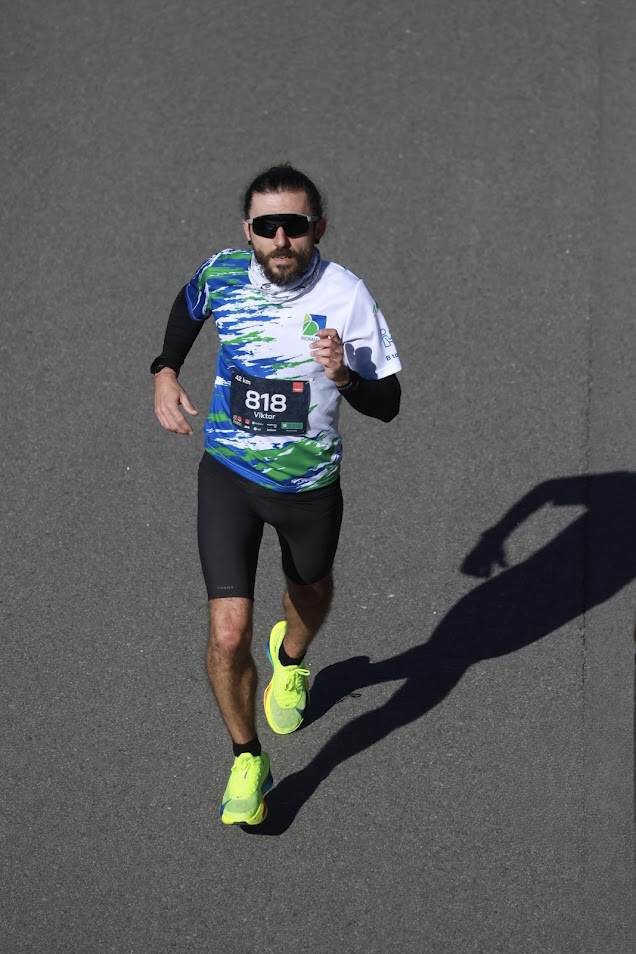Kaunas Marathon 2025
This year's Kaunas Marathon became a personal milestone - I finished with a new PB of 2:53. Two years ago, I ran my very first marathon right here in Kaunas in 2023, crossing the finish line in 3:22. Since then, it's been a journey of consistent training, learning, and tweaking what works for me. This year, I took a slightly unconventional route to improvement: not more volume - but more intensity...
Many marathon plans push for high weekly mileage. I didn’t follow that path. My average monthly volume during this training block was around 220-240 km - not so low, but definitely not in the "big mileage" category. Instead, I built my weeks around one key session: the Sunday long run, which was always the most important workout.
The rest of the week was preparation for that - mostly easy pace runs, recovery-focused. I also added 1–2 intensive hours of indoor cycling per week, which helped build endurance and speed without extra impact on my legs.
One key part of my fitness base came from my last race before this marathon: a 104 km ultra trail run, which I completed on October 22, 2024. That race gave me not only strength and endurance, but also the confidence to approach marathon prep differently.
In total, 2024 was my one of the most active year ever: I ran three marathons, completed one triathlon, one velorace, and that 104 km ultra. Every event taught me something new - and helped shape the runner I was going into Kaunas 2025.
It wasn’t my first experience with ultras either. Back in 2017, I took on some of my biggest endurance challenges: a self-supported 1,000 km run over 19 days along the Camino del Norte and a 24-hour endurance race. That was a long time ago, but those experiences built the foundation that still supports my endurance today...
So, preparation for the firs start of 2025 was...
Month 1 (February) – Easy Base Work. February was all about building a base. It was cold, and I kept things easy mostly Zone 2-3 effort. I ran 220 km that month, not pushing the pace but maintaining regularity. Because I keep running year-round (about 40 km/week average over the year), I already had a solid aerobic base. Even when I travel and have lower running mileage, those trips usually involve a lot of hiking, so I still stay active and strong.
Month 2 (March) – The Turning Point: Intensive Long Runs
This is where my strategy came to life. I kept weekly mileage stable, but increased the intensity of my long runs. Here's what that looked like:
28 km @ 4:16/km – almost holding my previous marathon pace (4:14/km)
33 km @ 4:36/km
36 km @ 4:36/km
36 km @ 4:22/km
36 km @ 4:25/km
(+200m ascent – this is my usual elevation for long runs)
Each of these was done once a week - just one quality long effort, then recover and reset.
Month 3 (April) – Sharpening the Blade
In April, I started tapering the volume of my long runs, but kept the pace high:
34 km @ 4:22/km
30 km @ 4:07/km – this was a breakthrough training session
22 km @ 4:07/km - race effort in the final week
The goal was to show my body what marathon effort feels like, without overloading it. And it worked. I arrived at the start line fresh, sharp, and confident.
Everything came together on race day, April 27th.. I paced well, held an average pace of 4:07, stayed strong, and crossed the finish line in 2:53:38 - a 29-minute improvement from my first marathon here just two years ago...
Sharing this day with my wife, who also achieved her half marathon personal best, made it even more memorable. Moments like this remind me why I love the process so much...
This journey showed me that you don’t always need more. Sometimes, it’s about running smarter, recovering better, and choosing intensity with intention.
If you’re not a high-mileage runner, but you’re willing to commit to one serious long run a week - and keep the rest of your training simple and sustainable - this approach might work for you too...

















Comments
Post a Comment